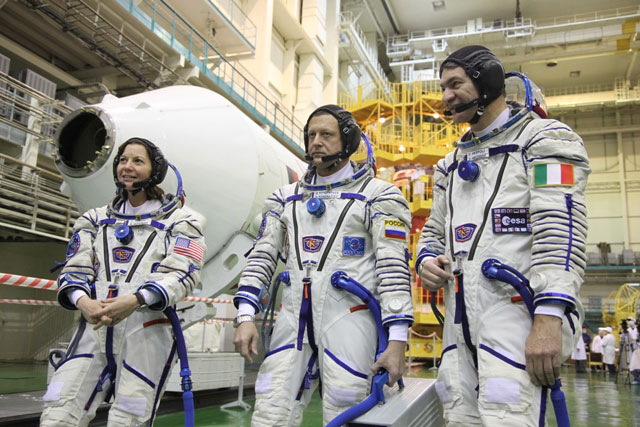Above: The primary crew of the Soyuz TMA-20 spacecraft during preparations for flight in Baikonur in November 2010 (left to right): NASA astronaut Catherine Coleman, Russian cosmonaut Dmitry Kondratyev and Italian astronaut representing European Space Agency, Paolo Nespoli. Credit: NASA
According to early schedules, Soyuz TMA-20 would be launched on Nov. 30, 2010. By the time the spacecraft arrived to Baikonur launch site on Oct. 3 2010, its liftoff was scheduled for Dec. 13, 2010. However in the process of unloading, or a day later during the installation of the spacecraft into its test rig at Site 254, engineers discovered some damage to the railway car, which was used to transport the spacecraft from the assembly center in Korolev, near Moscow to Kazakhstan. In reports by semi-official Russian media, industry sources rushed to blame the train machinist, who allegedly violated safety rules while driving the train, which caused one of the attachments of the spacecraft inside the railway transporter to break and the spacecraft to "fall." However posters on the forum of the Novosti Kosmonavtiki magazine said that the spacecraft was not secured correctly in the car by the manufacturer.
Whatever the reason, during the final leg of the trip, (which could be the responsibility of the Kazakh railways, if the railroad would ultimately be blamed), the spacecraft was reportedly shifting around inside its transporter along with movements of the train. However, on Oct. 7, Kazakh railway company said that on Sept. 30, 2010, it transferred the train to Russian authorities at the entrance to Baikonur with no complains from the Russian side. A day later, Kazakh railways also said that speed data recorded during the movement of the train showed no violations of any rules, no emergency breaks had ever been engaged and the train was driven by a highly experienced crew. In the end, Russian officials had never filed any formal complains against Kazakh rail ways and RKK Energia officials later quoted the possibility of damaging the spacecraft during its unloading in Baikonur upon the arrival to the launch center.
Although initially officials told that the problem would not affect the launch schedule, by Oct. 5, Russian media reported that the damage to the spacecraft itself was significant enough to require a return of the spacecraft to Korolev for refurbishment. The bottom shield of the descent module, SA, reportedly shifted by 1.5 millimeters, possibly causing small cracks in the structure and damage the shield's attachment locks. In addition, a special covering on the propulsion section of the spacecraft was breached.
By October 8, after weighing an option of returning Soyuz TMA-20 to Korolev, Russian space officials made a decision to replace its descent module, SA, in Baikonur. The hardware prepared for Soyuz TMA-21 would be used. Despite an additional time needed for repairs, Russian officials said that the launch of Soyuz TMA-20 would still take place before the end of 2010, possibly with a delay of few days, comparing to the previous schedule. The launch date of Dec. 27 was initially quoted, but a delay from 10 days to two months was considered likely by European officials involved in the mission. By October 12, a new descent module has arrived to Baikonur onboard a transport plane. Along with it, a group of engineers flew to Baikonur to support three-shift work on the replacement of the descent module. According to Roskosmos, the replacement was completed by October 16, 2010. Four days later the spacecraft was ready for tests at the vacuum chamber. By Oct. 22, the launch date for the Soyuz TMA-20 had been set for December 15, 2010.
Tallest crew member
Another complication in the runup to the Soyuz TMA-20 flight was caused by the record height -- 188 centimeters -- of the European astronaut Paulo Nespoli. According to president of RKK Energia, Vitaly Lopota, a custom-built seat and related hardware had to be manufactured, after the company had first discovered how tall Nespoli was. Nespoli was believed to be the tallest crew member ever to fly onboard Soyuz.

No comments:
Post a Comment